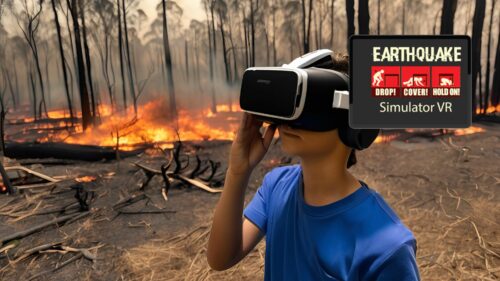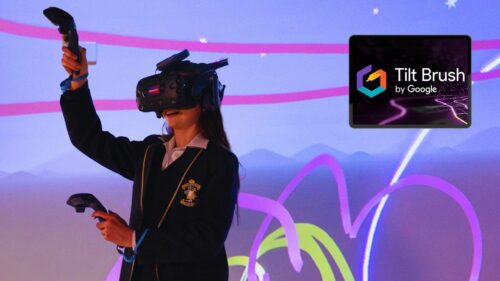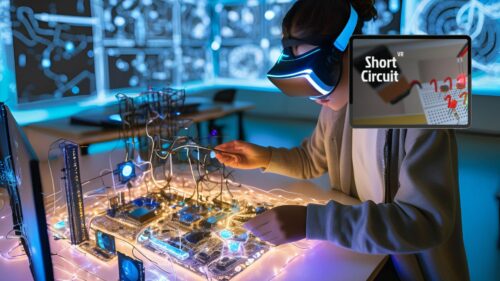Task Summary
In Part A students will engage in research and building understanding and empathy or virtual sports and fitness. They will complete some critical thinking exercises in their Student Digital Notebooks.
In Part B, students will create their own virtual fitness and sports routine for students who are remote or isolating using Thinglink to present.
Learn MorePreparation
Students are expected to:
- Have some background in using IMVR.
- Have some understanding of how to use All-in-One Sports VR in IMVR.
- Have some background on using the HHVR headsets.
- Have some background in using Thinglink.
- Have some knowledge on using Ricoh Theta360 cameras (please see lesson plan on this if students are not knowledgeable)
Teachers should make sure that:
- IMVR headsets are calibrated and batteries are charged.
- They are familiar with the All-in-One Sports VR experience using IMVR.
- They are familiar with using Thinglink and have class logins
- Are familiar with using Ricoh Theta360 cameras.
- The apps listed in the resources section have been downloaded onto devices and logged in.
- Fitness VR- Teaching Deck has been checked and the teacher has enabled the deck’s accessibility so students can access it.
- Padlet link has been added to slide 11 on Teaching Deck and slide 12 on Student Digital Notebook.
- Students are divided into pairs or groups for Part A, depending on how many devices are available. A suggested rotation cycle may be:
| Group | Round 1 | Round 2 | Round 3 |
| Group 1 | IMVR | App Testing | HHVR |
| Group 2 | HHVR | IMVR | App Testing |
| Group 3 | App Testing | HHVR | IMVR |
This may differ based on student numbers and number of IMVR stations
Learning Sequence
Part A
- Show students the Pokemon Go Image on slide one of the Fitness VR- Teaching Deck.
- Discuss the following question in pairs/ groups:
- What are your initial thoughts on this?
- Does it classify as PE?
- Who would this course be beneficial for?
- Answer in dot points in their Fitness VR- Student Digital Notebook(Slide 2)
- Introduce the stations students will be engaging in Station Based Rotations in 10-15 min intervals
Station 1 – IMVR
- Students are to engage with All-in-One Sports VR in IMVR. They can choose one or two sports to engage in and try to focus on rather than hopping through many quickly.
- Answer in their Fitness VR- Student Digital Notebook(Slide 4)
- How did I feel physically during this experience (heart rate, exertion etc.)
- How did it help PE related skills? (aim, focus, technique etc.)
- Answer in their Fitness VR- Student Digital Notebook(Slide 4)
Station 2 – HHVR
- Students watch Trinity Workout: 360° Video Circuit using HHVR. This is divided into 3 sections with variations – Squats, Planks, and Lunges. After watching each section, students pause the experience and complete 30 secs – 1 min (adjust to suit class and timing) of each variation.
- Complete a critical reflection in their Fitness VR- Student Digital Notebook(Slide 5)
- What were the pros of completing an exercise like this?
- What were the cons?
- Where would this type of technology be most beneficial in PE?
- Complete a critical reflection in their Fitness VR- Student Digital Notebook(Slide 5)
Station 3 – App Testing
- Students are to choose and test one of the pre-loaded fitness apps on the devices:
- Zombies, Run (will need headphones)
- The Walk
- Complete the following questions in their Fitness VR- Student Digital Notebook(Slide 6)
- What were the pros and cons of this experience?
- What changes would you make to it?
- How is this type of app beneficial?
- Students can come back together in small groups and share experiences and notes. Answer in their Fitness VR- Student Digital Notebook(Slide 7):
- Rate each experience in regards to motivation, ease of use, physical exertion, skill development.
- If you could change one thing about each experience, what would it be?
- Where would you see virtual reality fitting into PE?
Part B
- Ask students to spend 10 minutes playing the following ‘fitness board game’ on Thinglink.
- Introduce to them that they will be making a similar product in their pairs/ small groups.
-
- Interactivity
- Technology
- Presentation
- Engagement
- Ease of use
- Either skill development focused, or cardio focused
- Students will need to use Thinglink to create a ‘fitness’ lesson or series of activities for students who are learning remotely. They will need to consider the following:
- They can either make a series of small curated activities, or one more involved one where they create their own content using a 360 camera/ regular camera/ app.
- They will use Thinglink to present their fitness activity/ies similar to the board game and further examples in their Fitness VR- Student Digital Notebook.
- Students to share their Thinglink content to the teacher-prepared Padlet (or choice of sharing platform).
Download the PDF for more information



